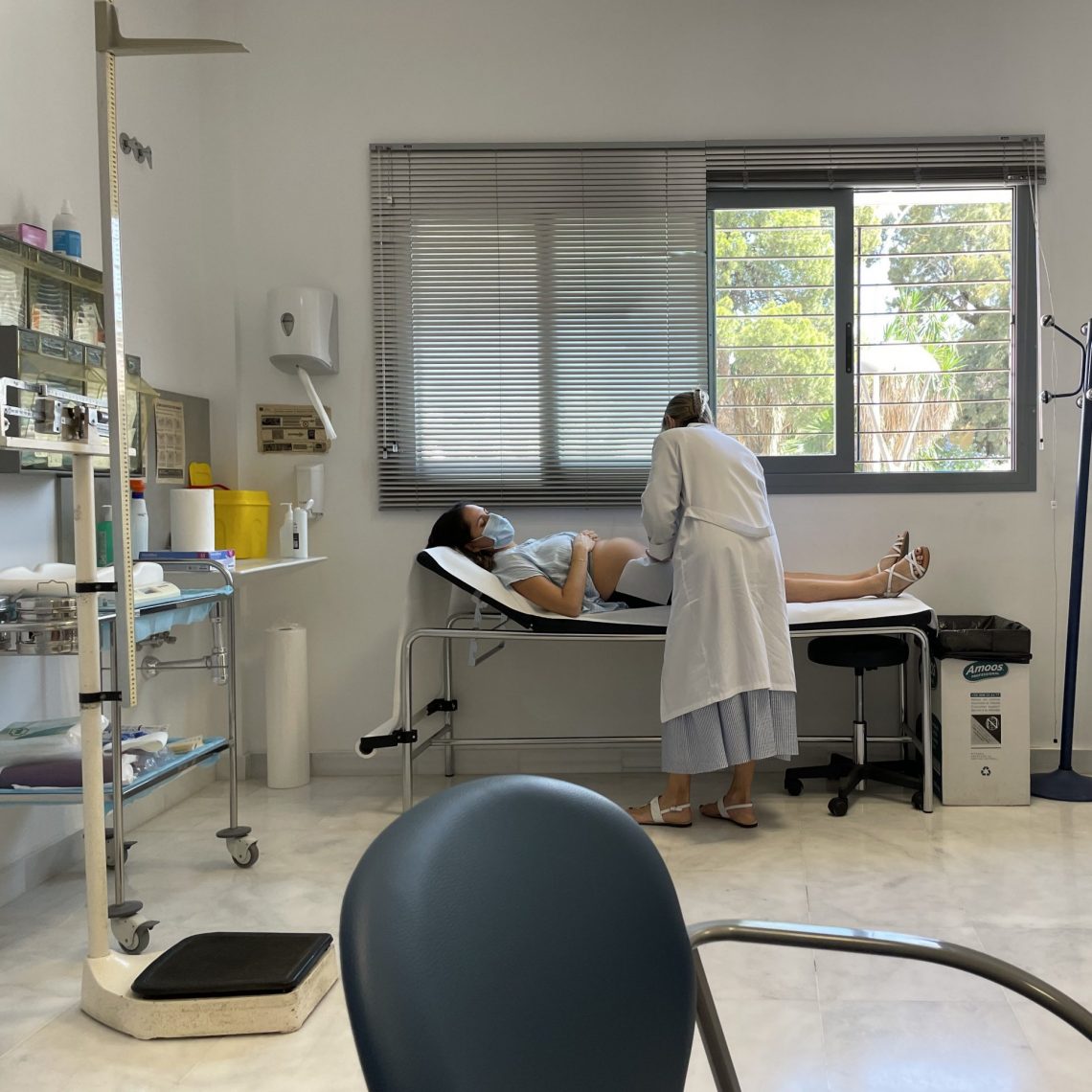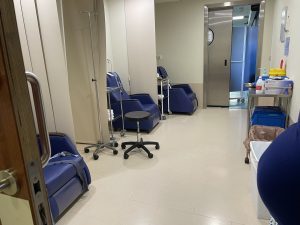
What to Expect When Pregnant in Spain

 Dear Lena,
Dear Lena,
I know how overwhelming it can be to go into the medical process around your pregnancy with little to no idea of what will be in store for you. For this reason, I wanted to provide a rough outline of the different appointments I had throughout the process, some useful Spanish vocabulary to know, and thoughts on choosing between the public and private system.
However, please be aware that this article was written in accordance with my PERSONAL experience and yours could differ greatly depending on a number of factors. For example, (1) where you live in Spain, (2) if you use the public healthcare system, the private healthcare system, or both, (3) the sort of private health insurance policy you hold, and (3) the intricacies of your pregnancy will all affect your experience.
As an additional reference, please check out this guest post from a doula who is well-versed in what the process tends to look like in Madrid.
Understanding the Pregnancy Process in Spain
First things first, let’s take a look at what the pregnancy process looked like for me here in Spain. For context, I live in Andalucía and have both public and private healthcare coverage. I also had a very smooth, low-risk pregnancy which means I generally didn’t require any follow-up tests, scans, or monitoring outside of the standard ones (which would, of course, have required more appointments).
Everything I had previously read about the pregnancy process in Spain made it seem that appointments wouldn’t typically start until Week 10 in the private system or Week 12 in the public system so I didn’t rush to see my doctor. However, I don’t necessarily advise you to do the same. In retrospect, I would recommend seeing your (public) general practitioner or (private) OB-GYN sooner (perhaps around Week 6-8*) so that they can calmly book you in for your first control de embarazo (pregnancy-specific) appointments.
My story: I didn’t realize that I would need to have the 1st Trimester Analítica done in Week 10, so when I didn’t see my GP until Week 9, she made a big to-do about getting me booked in for all of my necessary appointments as soon as possible.
There was some miscommunication with the administrator in charge of booking my appointments and she therefore got my booking-in appointment with the midwife, 1st Trimester Analítica, and 1st Trimester ECO (ultrasound) scan all scheduled within the following nine days. Her interpretation of “as soon as possible” was extreme and didn’t take into account the correct timing of such appointments.

Thankfully, when I saw the midwife the very next day, she realized the error and changed my appointments to when they should be. However, I had plenty of time to get emotional and overwhelmed after leaving the centro de salud the first day before it was all fixed and I wouldn’t wish that upon any other hormonal pregnant woman.
Likewise, because of the overwhelm I felt at the start in the public system, I avoided adding the stress of getting the process started in the private system for quite some time. I hadn’t decided yet which route I would take and the initial stress had me thinking I would just forgo the private system. (I had moved within the last year, so I didn’t have a local OB-GYN and thus the barrier to entry in the private system felt greater to me.)
For this reason, you’ll see that I didn’t start the process in the private system until halfway through my pregnancy (when I got more serious about wanting both options available to me) and, towards the end, I discontinued my use of the public system. Had I pursued both from the start, of course, I would have had additional appointments on both sides.**
*Some other moms I know did, in fact, get their first scan during this time frame.
**Please let me know if you would be interested in me sharing other women’s timelines in a future post if an opportunity to compare and contrast is appealing.
Dani’s Timeline
| Week of Pregnancy | Public System | Private System |
| Week 9 | – Consult with my general practitioner → first of the “control de embarazo” appointments set up
– Booking-in appointment with my midwife |
N/A |
| Week 10 | 1st Trimester Analítica | N/A |
| Week 12 | – 1st Trimester Analítica Resultados
– 1st Trimester ECO scan |
N/A |
| Week 13 | Repeat of 1st Trimester ECO scan (due to my baby’s size not yet meeting the threshold needed for proper measurements) | N/A |
| Week 16 | Midwife Check-up | N/A |
| Week 21 | 2nd Trimester ECO Scan (Anatomy Scan / 20-week Scan) | Booking-in appointment with a gynecologist (also included an ECO scan) |
| Week 24 | Midwife Check-up | None |
| Week 25 | 2nd Trimester Analítica (including glucose test for gestational diabetes) | None |
| Week 26 | None | OB-GYN check-up + ECO scan + 3D scan |
| Week 27 | 2nd Trimester Analítica Resultados | None |
| Week 29 | – Midwife Check-up (included receiving the Tdap shot)
– Prenatal Class #1 (postpartum) |
None |
| Week 31 | Prenatal Class #2 (lactation) | OB-GYN check-up + ECO scan |
| Week 32 | None | Guided Tour of Private Hospital |
| Week 33 | 3rd Trimester ECO Scan | None |
| Week 34 | Guided Tour of Public Hospital (included an information session on breastfeeding, diaper changing, and further newborn care) | None |
| Week 35 | Prenatal Class #3 (newborns) | None |
| Week 36 | – Midwife Check-up
– Prenatal Class #4 (birth) |
OB-GYN check-up + ECO scan |
| Week 37 | N/A | 3rd Trimester Analítica (including vaginal/rectal swab for GBS test) |
| Week 38 | N/A | – 3rd Trimester Analítica Resultados
– Fetal monitoring – OB-GYN check-up + ECO scan |
| Week 39 | N/A | – Further 3rd Trimester Analítica (due to doctor error)
– Fetal monitoring – OB-GYN check-up + ECO scan |
| Week 40 | N/A | – Further 3rd Trimester Analítica Resultados
– Fetal monitoring – OB-GYN check-up + ECO scan (including discussion of my birth plan) |
| Week 41 | N/A | – Fetal monitoring
– OB-GYN check-up + ECO scan (including discussion of induction options) |
| Week 42 | N/A | – Fetal monitoring
– “Pre-induction” scheduled for 41w+5d – Induction → labor + birth at 41w+6d |
Some useful vocabulary to know

- FUR (fecha última regla): the date of your last period, this data is asked of you often and used to calculate your due date; you give the first day of your last period)
- FEP (fecha estimada del parto) / fecha probable parto: the estimated or probable due date
- Semana gestacional / semana amenorrea: week of pregnancy / without menstruation
- ¿A cuántas estás?: How far along are you?
- Visitas de control de embarazo: routine pregnancy appointments
- Matrona / madrona / comadrona: midwife
- Ecografía (ECO, pronounced ‘echo’): ultrasound scan
- Analítica: analysis, typically blood and/or urine tests but can include any kinds of testing
- Ayuno: fast (analíticas are typically done first thing in the morning, after having fasted for 8-12 hours)
- Resultados de la analítica: test results (in the public system: you typically need to book a follow-up appointment 3-7+ days after the test[s] to receive these from your doctor; in the private system: you’d collect them yourself to bring to your doctor at your next appointment)
- Grupo sanguíneo: blood type
- Vacunación frente a tosferina (Tdpa): Tdap vaccine (includes whooping cough protection for mother and baby, recommended for pregnant women at 27/28 weeks)
- Documento de la salud de la embarazada / Cartilla de embarazada: pregnant woman’s health documents / little book (given to you and filled in at appointments by your midwife or doctor)
- Hospital Materno y Infantil: Maternity and Children’s Hospital
- Hospital universitario: university hospital (where midwives and doctors are trained)
- Centro de salud: health center / doctor’s clinic
- Educación maternal: prenatal classes
- Bajo riesgo: low risk
- Alto riesgo: high risk
- Intervenciones: medical interventions
- Inducción: induction of labor
- Pre-inducción: “pre-induction” (procedure to encourage uterine contractions)
- Seguro social: public healthcare coverage
- Seguro privado: private healthcare insurance
- Cobertura: coverage
- Autorización: authorization (sometimes needed for particular procedures with private insurance)
- Cuadro médico: “medical chart” (a list of doctors, clinics, etc that are covered by your private insurance plan)
Choosing Between the Public and Private System for your Pregnancy / Birth Experience in Spain
There are plenty of differing factors to consider between each system and, if you have both options available to you, it’s important to do your own research in your area. In case it helps you, these are the differences I found in my experience–specific to the public and private hospitals I considered in Málaga, Spain. The specifics may vary from hospital to hospital and/or region to region).
| PUBLIC | PRIVATE |
| As a registered resident (empadronado), the cost is completely covered by public healthcare. | The cost is generally covered if you have held a private insurance policy (that covers hospitalization) for eight months. However, keep in mind that your particular insurance company may not cover ALL procedures at all private hospitals / clinics and your typical co-pay (copago) rates, if you have them, will apply. For example, if your insurance company tends to charge you a 10€ co-pay to see specialists, this will continue to be the case each time you see your OB-GYN. |
| You will have fewer appointments, but also less flexibility as to when those appointments are scheduled. You will likely see different medical professionals each time you visit the hospital for ECO scans. You receive only one ECO scan per trimester and this generally does not include a 3D scan. | You will have more appointments, but private hospitals/clinics tend to be more accommodating and schedule appointments around you. You will have all of your ECO scans with your OB-GYN. Practices seem to differ by clinic/hospital, but ECO scans can happen anywhere from every 3-5 weeks until Week 38. Then, it is common to receive one every week at your OB-GYN check-up. |
| You should have no surprises or complications when it comes to where to go. You will have your tests done at the same clinic where you see your general practitioner and (usually) midwife. Your general practitioner remains your point-of-contact for tests and results. All tests, scans, etc (even those at the hospital) are booked internally through this clinic. | You may run into a few more complications and surprises when it comes to where you need to go to have procedures covered by your insurance. (I ran into an easily-avoidable predicament when I believed the staff at the hospital where my consults, ECO scans, and hospitalization were covered. It turns out that my insurance provider did NOT cover analíticas in their hospital [but did elsewhere].) Be sure to consult your cuadro médico even when it seems unnecessary. |
| Midwife-led: a midwife is the main point of contact throughout pregnancy and labor. A doctor would only be called in for complications / high risk situations. | Doctor-led: an OB-GYN is the main point of contact throughout the pregnancy. Midwives are involved in labor, but it is a doctor who delivers the baby. (At least this was the case at the private hospital I chose. Friends who gave birth at different hospitals had midwives deliver their babies.) |
| You are unlikely to know any of the midwives or doctors present on the day of your baby’s birth. | There is a higher chance that your OB-GYN will be present on the day of your baby’s birth, but there is no guarantee. (And, if your doctor promises that, you may actually want to be weary. Sometimes, this is a sign that doctors are scheduling induced labors when there is no medical reason to do so.) |
| Especially if your public hospital is a hospital universitario, there are a lot of midwives- and doctors-in-training. (It is always your right to say no to non-essential healthcare workers being involved in your experience, but with the frequency of their presence, you may not feel comfortable saying no constantly, especially if understaffing is an issue, as it is at the public hospital I visited.) | There is a much lower chance of coming into contact with midwives- or doctors-in-training at private hospitals. (But, again, if you do, it is your right to say no.) Understaffing is also not as likely of an issue, though it can be during the summer and holidays. |
| The first stage of your labor happens in a shared room (typically a ward with 6+ beds). That being the case, you cannot be accompanied by anyone during the first stage of labor, to provide privacy for all. | Every stage of labor (except monitoring, if needed in the first stage) happens in a private room. Therefore, you can be accompanied by one person throughout the whole process. |
| You are only allowed to have one person to accompany you during labor. Thus, you would not be allowed to use a doula or additional birth partner. The only exception is that you are allowed a translator if you do not speak Spanish. | There is more of a possibility, but no guarantee, that you would be allowed a doula or additional birth partner. Check with the hospital beforehand on their policy. You can also ask for written agreement on this from your OB-GYN prior to birth. (Doulas and private midwives can provide insight into local hospitals, practices and birth options (including home birth) in your area.) |
| Your postpartum stay also happens in a shared room (typically a smaller room with only 2 beds and a bathroom). If the hospital is not too busy, you may end up on your own but there is always the possibility that another woman will be assigned to your room. That being the case, there is typically only a chair for each woman’s birth partner and the bathroom/shower within your postpartum room can only be used by females. | Your postpartum stay happens in a private room. That being the case, there is typically a couch that converts into a bed for your birth partner and the bathroom/shower within your postpartum room can be used by your birth partner and any visitors, regardless of gender. |
| There are limited visitation hours (for example, between 4 and 8pm) and you can only have two other people in your room at any time. This means that if both of your parents came to visit at once, your birth partner would need to leave the room or your parents would need to visit one at a time. | Visitation hours are not limited and neither are the number of visitors (within reason). The midwives and/or nurses will advise you to have fewer visitors or to wrap up a visit if they feel it is too much for mother and baby, but there is no set policy. |
| Public hospitals in Spain are known for having the most advanced technology and most qualified specialists. For this reason, it is typically advised that you give birth in a public hospital if you/your baby have any high risk factors or if you go into labor prematurely.
The concern is typically that if your baby is born in a private hospital, but requires specialized care, they will have to be transported to a public hospital anyway, rendering it better to give birth in one to begin with. This may or may not be the case since the 2020 Coronavirus outbreak (see right). |
All of my prior research and advice from other moms led me to believe that a private hospital was only the right choice if I were to go into labor after a low-risk, full-term pregnancy.
However, in the case of the particular private hospital I visited, they also boasted a fully functioning neonatal unit, advanced technology, and qualified specialists. Back in 2020, measures were taken to greatly improve their NICU and other such offerings and, since then, they have not needed to transport a single baby to the public hospital. For me, this rendered this point moot. |
| Public hospitals are generally viewed as promoting a more “traditional” birth experience (laboring on your back, with an epidural, and more medical interventions.)
Personally, I did not find this to be completely true. The public hospital I visited had all of the “modern” installations for women who prefer a more natural birth experience. The delivery room was stocked with a birthing ball, a birthing stool, and even a birthing pool (although, due to understaffing, they were not able to be used). |
Private hospitals are generally viewed as being more open and accommodating of “modern” approaches to the birth experience.
Interestingly, the private hospital that we visited did not have delivery rooms stocked with a birthing ball, birthing stool, or birthing pool (but others in the area did). During labor, we were able to gain access to some of these instruments [barring the pool], but it was not super clear what was available, and also seemed limited to the number of other laboring women asking for the same tools). |
| The pregnancy process will likely take place in Spanish. Some public hospitals will have English-speaking staff and all should offer you access to a translator if needed, but there is no guarantee that you will get English-speaking medical staff, nor that their level of English will put you at ease if you do not have strong Spanish skills. | It would be easier to go through the pregnancy process in English. With private insurance, you can search for English-speaking OB-GYNs in your cuadro médico when booking your appointments. There also tends to be greater availability of English-speaking medical staff in private hospitals so you’re more likely to receive assistance in English during your labor if you request this. |
I want to reiterate how important it is to do your own research in your area. As you can tell from the chart above, there were definitely some differences that I believed to exist between the systems that, in reality, were not necessarily true. And there are probably other differences that exist that I simply did not notice because of my own priorities being different to yours. Things are always changing and hopefully getting better in each system, but for this reason I highly recommend that you get to know the options in your area personally.
Whenever possible, book a guided tour (tour guíada) at the hospital(s) you are considering so you can get a feel for things yourself and get your questions answered by the staff who are actually present during births.
Which I Chose and Why
Ultimately, my husband and I made the decision to give birth in a private hospital. For the most part, this came down to a personal choice, not a feeling that the private system was actually superior to the public system.
The pros we saw in the private system
(1) the more modern, welcoming feel of the hospital
(2) having my partner with me throughout the entirety of the labor process
(3) the guarantee of a private postpartum room

Please note that when I say “more modern feel” I am not actually referring to any more advanced technology at the private hospital. Rather, the building, rooms, and installations themselves simply had a newer, cleaner, more welcoming vibe. We noted things like soft music playing over the intercom in the hallways, computer screens in the waiting rooms to direct you to your doctor’s office when called, and a generally more available and friendly staff*. All of which was not necessary, but put us at ease.
* I do not say this as a put-down of the public hospitals staff. During our guided tour we were impressed by their installations and the passionate medical staff there. It’s simply a reality that the public system is more in-demand and so understaffing can lead workers to being stretched thin and less able to accommodate each individual patient. On the other hand, private hospitals are essentially businesses and so presentation and ambiance is something they can and do invest money into.
The option to have my partner by my side throughout my whole birth experience as well as know that we would have privacy in the days following our baby’s birth is a luxury that we decided was important to us and this weighed heavily on our decision. Similarly, the location of the private hospital we chose was preferable as it was more easily accessible by public transport (requiring only one bus from the suburb where we live / my parents would be staying).
If you choose to use the public system in Spain for your birth, I believe you will be in very capable hands and have every need met. Honestly, after some of the miscommunications and frustrations we encountered throughout my experience in the private system, I would very much consider this route for any future births.
The cons we experienced in the private system
(1) misinformation and lack of organization between hospital/clinic and insurance provider
(2) unexpected fees

I alluded to this earlier on, but the way things are organized between private hospitals/clinics and private insurance providers is not always ideal. Because your hospital/clinic will likely accept a number of different insurance providers, there’s no guarantee that the administrator you are speaking to when booking appointments, analíticas, etc has a strong grasp of what is covered by YOUR insurance provider. For this reason, we were sometimes given incorrect information. (And, frustratingly, it happened in connection with my 3rd Trimester Analítica, so I was heavily pregnant, fasting, and yet driving all over the city for two hours trying to find a clinic that was covered by my insurance provider.)
Additionally, we often found the procedure of booking next appointments to be unnecessarily confusing in the private system. In the public system, my midwife handled all of the logistics. She would tell us what appointments, tests, etc I needed next and book them all for me on the centralized database while we sat in her office. Thus, there was never any confusion about what type of appointment was required, when the appointments should be scheduled, or where I would need to go.
In the private system, my OB-GYN would simply say things like “get another appointment for two week’s time” and then it was up to me to go to the administration desk or my online portal to book the following appointment. The first time, I opted to do this on my own online. I assumed that my doctor would have put a note on the system as to what I needed next. However, I quickly learned that this wasn’t the case and I didn’t know which kind of appointment to book. This caused more stress, leading me to always make the appointments with an administrator before leaving the hospital.
Even so, I often felt at a loss when they would ask me for details and/or to make the decision to see the doctor a little bit earlier or later than he had indicated, or to see a different doctor on the exact date. As a layperson, I didn’t know what was best and would have appreciated having professional input in such decisions, but I didn’t get any.
Finally, I will admit that I didn’t, at first, realize there would be co-pay fees associated with my control de embarazo appointments. While it makes sense that these were all consults with specialist doctors, something I typically pay a small copago for, whenever I researched childbirth coverage on my insurer’s website, I found that these procedures should be fully covered. It turns out, this meant the actual childbirth, hospitalization, and procedures carried out while in hospital, not the standard OB-GYN appointments leading up to birth. (Note: This will depend entirely on your private insurance coverage. If you have a plan with no co-pays, then you will, of course, have no co-pays associated with this process either.)

I did not incur additional fees for the ECO scans or monitoring sessions, but I was charged a 10€ co-pay for each doctor visit and a 14€ co-pay for the analíticas that I did (I did my first two analíticas through the public system and would recommend others do the same for all of their tests). I didn’t realize this would be the case for some time because my private hospital was very delayed in charging my insurance company and the co-pays didn’t come through until two months later.
Overall, the choice between public and private healthcare for your pregnancy and the birth of your baby comes down to a personal choice and I would refrain from saying there is a generally “better” choice. If, like me, you have been paying for private healthcare coverage for some time it might just make economical sense to take advantage of that coverage and go to a private hospital.
On the other hand, if you don’t have private healthcare that would cover childbirth and hospitalization, I don’t personally think it would be worthwhile to pay for it out of pocket. My understanding is that fees for this would start at around 1200€. As a pregnant person in Spain (resident or not) you have the right to childbirth care and hospitalization in the public system. Note: This does not necessarily mean all the control de embarazo appointments leading up to labor. (But everything is included and covered for residents.)
I hope that learning a bit more about how the pregnancy process went for me in Spain, as well as the thought process behind why I chose to give birth in a private hospital, will help you feel more informed and comfortable if you are embarking on the same journey.
I would be happy to share more about my experience with childbirth and the postpartum stay in a private hospital and/or maneuvering the first few months of medical appointments for babies if it is something that interests readers, so please do let me know any thoughts or questions you have in the comments!
Sincerely,
Dani




